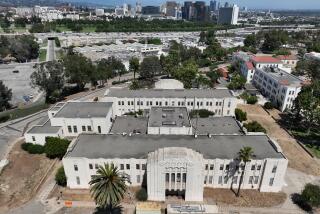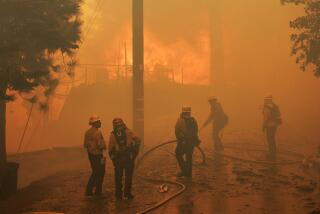Burned Military Center Won’t Be Rebuilt : South L.A.: The area is too dangerous for an enlistment station, Pentagon says. Leaders charge that the government pullout is hypocritical.
While President Bush and other government officials have encouraged business leaders to rebuild and invest in riot-ravaged areas, a military enlistment center that burned down will not be rebuilt at its southwestern Los Angeles location, partly because Department of Defense officials consider the area too dangerous.
The relocation of the Military Entrance Processing Station and an adjacent recruiting center eventually could mean the loss of about 500 jobs to the neighborhood. And, community leaders say, the relocation sends out the wrong signal to business owners and investors who are considering whether to rebuild in the area.
“This is the height of hypocrisy,” said state Sen. Diane Watson, a Los Angeles Democrat who is running for a seat on the Board of Supervisors. “President Bush comes out here and says the solution to urban problems is jobs and enterprise zones, not government aid. So what happens . . . the one federal agency that hires a lot of young black men--the military--pulls out as soon as they can.”
The enlistment station, a Department of Defense agency, is the headquarters for screening and induction of all military recruits in nine California counties. The 30,000-square-foot station, which stood for seven years on South La Brea Avenue near Jefferson Boulevard, burned to the ground on the first night of the riots.
The private owners of the building, who are fully insured, offered to construct a temporary facility within a few weeks and rebuild the structure within eight months. But the offer was rejected by the General Services Administration, which handles real estate transactions for the federal government, according to Allan Davidov, a partner of the company that owns the property.
“Our main concern is that we have a safe environment and safe workplace . . . and it’s pretty evident that’s not a safe environment,” said Suzanne Fournier, public affairs officer for the Military Entrance Processing Command, based in Chicago. “We have to have a safe environment, not just for our employees, but also for our applicants.”
U.S. Rep. Maxine Waters of Los Angeles said she was incredulous that the military--which is supposed to protect residents--considers the area too dangerous.
“This is the military that fights in Iraq and places like that, yet they consider South-Central L.A. too dangerous?” she said. “I can’t believe I’m hearing that.”
Adjacent to the enlistment station, which employs about 80 people, is an undamaged two-story brick building that houses the Southern California recruiting headquarters for the Air Force, Army, Navy and Marines. But Davidov said he was told by General Service Administration officials that the military will not renew its lease when it expires in three years.
A GSA spokeswoman said the agency will be searching for a site that will be able to house the enlistment station and the recruiting headquarters. As a result, about 500 jobs will be leaving the area.
Since the riots, Bush has stressed the creation of “urban enterprise zones” where businesses are encouraged through tax incentives to invest in central cities, expand low-income housing and provide job training.
But when the government “refuses to make a commitment” to South Los Angeles, “what kind of message does this send to private industry?” asked Lloyd Johnson, a chairman of the Baldwin Neighborhood Homeowners Assn.
“The government is saying one thing and doing the opposite,” he said. “How are we going to attract investment and build up our community when the government sends this kind of negative signal?”
Federal officials already were considering whether to move the enlistment station, Fournier said, but the riots speeded the decision. The facility was too small, she said, needed design changes and was not centrally located in the recruiting area. Dave Taylor, chief of real estate for the Army Corps of Engineers in Los Angeles, said the new enlistment station probably will be located east of the Los Angeles area.
The owners of the property say they are surprised that government officials say there were problems with the site. A year ago, the commanding officer of the enlistment station sent them a letter that congratulated them on receiving “the grading of excellent on the recent annual general inspection” of the facility.
By relocating, the military is sending the wrong signals “to people like us,” said Davidov of Spectrum Partners, which owns 15 acres and numerous businesses in the urban neighborhood.
“On one hand, the U.S. government is telling businessmen like us to invest in South-Central Los Angeles, to bring in capital and rebuild the area,” Davidov said. “Yet one of the first tenants to move out of the area because of the rioting is an arm of the U.S. government. Besides putting a tremendous financial burden on our company, it’s also creating a vacuum in this community.”
The enlistment station and recruiting headquarters were “an anchor of the community,” said Johnson of the Baldwin Neighborhood Homeowners Assn. The 500 employees generated tremendous business by shopping in the local stores and eating in the neighborhood cafes, Johnson said. After the riots, he added, the community anticipated losing some businesses that could not afford to rebuild. Residents didn’t anticipate losing government offices.
“In the last few weeks we got some early commitments to rebuild from a lot of businesses, like Fedco, Boys Markets and other major companies. They said: ‘We’re committed to your community and we’re going to work with you.’ I expect the same sort of commitment from the federal government. I don’t understand why we don’t have it.”
City Councilman Nate Holden said he plans to lobby members of Congress to rescind the order to relocate the enlistment station.
“We need people who stay and rebuild and lead by example,” said Holden, who represents the district surrounding the enlistment station. “The last thing we need is a visible governmental agency that shows no faith in our city.”
More to Read
Get the L.A. Times Politics newsletter
Deeply reported insights into legislation, politics and policy from Sacramento, Washington and beyond. In your inbox three times per week.
You may occasionally receive promotional content from the Los Angeles Times.










